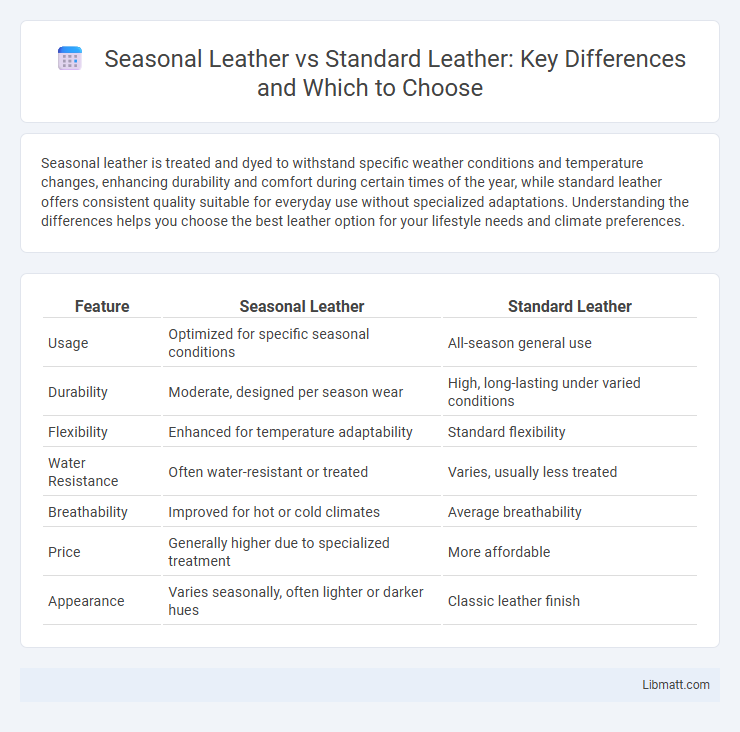Seasonal leather is treated and dyed to withstand specific weather conditions and temperature changes, enhancing durability and comfort during certain times of the year, while standard leather offers consistent quality suitable for everyday use without specialized adaptations. Understanding the differences helps you choose the best leather option for your lifestyle needs and climate preferences.
Table of Comparison
| Feature | Seasonal Leather | Standard Leather |
|---|---|---|
| Usage | Optimized for specific seasonal conditions | All-season general use |
| Durability | Moderate, designed per season wear | High, long-lasting under varied conditions |
| Flexibility | Enhanced for temperature adaptability | Standard flexibility |
| Water Resistance | Often water-resistant or treated | Varies, usually less treated |
| Breathability | Improved for hot or cold climates | Average breathability |
| Price | Generally higher due to specialized treatment | More affordable |
| Appearance | Varies seasonally, often lighter or darker hues | Classic leather finish |
Introduction to Seasonal Leather and Standard Leather
Seasonal leather is specially treated to withstand varying weather conditions and temperature changes, offering enhanced durability and flexibility throughout the year. Standard leather, typically untreated or minimally processed, provides a classic look and feel but may lack the resilience needed for extreme seasonal shifts. Your choice between these leathers affects not only the lifespan of the product but also its comfort and maintenance requirements.
Key Differences Between Seasonal and Standard Leather
Seasonal leather is specifically treated to withstand varying weather conditions, offering enhanced water resistance and breathability compared to standard leather, which is generally designed for everyday use without specialized weatherproofing. Seasonal leather often features coatings or finishes that protect against moisture and temperature fluctuations, making it ideal for outdoor wear during specific seasons. In contrast, standard leather prioritizes durability and a natural appearance, with less emphasis on weather-specific functionality.
Material Composition and Sourcing
Seasonal leather is crafted from carefully selected hides that undergo treatments tailored to varying weather conditions, often sourced from regions with distinct climates to optimize durability and breathability. Standard leather typically involves more uniform tanning processes and originates from conventional suppliers without specific attention to seasonal performance. Your choice between seasonal and standard leather impacts the material composition, influencing comfort and longevity based on the sourcing and treatment methods employed.
Durability and Longevity Comparison
Seasonal leather undergoes specialized treatments to enhance resistance against weather variations, offering improved durability during temperature fluctuations compared to standard leather. Standard leather, while generally sturdy, may show signs of wear faster when exposed to extreme seasonal changes without protective treatments. Your investment in seasonal leather can result in longer-lasting products that maintain quality and appearance through varying climate conditions.
Aesthetic and Texture Variations
Seasonal leather exhibits unique aesthetic and texture variations that reflect changes in animal hide quality and tanning processes throughout the year, often resulting in more pronounced grain patterns and natural color shifts compared to standard leather. You will notice seasonal leather tends to have a richer, more dynamic patina with subtle textures that evolve over time, offering a distinct tactile experience. In contrast, standard leather maintains a consistent look and feel, designed for uniformity and predictable durability across batches.
Seasonal Leather for Fashion Trends
Seasonal leather adapts to current fashion trends by using unique textures, colors, and finishes that reflect the latest styles, offering a fresh and trendy look compared to standard leather. This type of leather often incorporates seasonal dyes and treatment techniques to complement the evolving palette of each fashion season. Your wardrobe can benefit from seasonal leather pieces that provide both high quality and on-trend appeal, setting you apart effortlessly.
Standard Leather for Timeless Appeal
Standard leather offers timeless appeal due to its classic texture and durability, making it a preferred choice for long-lasting products. Its consistent quality and ability to develop a rich patina over time enhance the aesthetic value of leather goods. Unlike seasonal leather, standard leather maintains its appeal regardless of fashion trends, ensuring versatility and enduring style.
Climate Adaptability and Performance
Seasonal leather is engineered for enhanced climate adaptability, incorporating breathable and moisture-wicking properties that regulate temperature and moisture in varying weather conditions. Standard leather, typically thicker and less ventilated, excels in durability but may trap heat and moisture, reducing comfort in hot or humid climates. Performance-wise, seasonal leather offers superior flexibility and comfort for fluctuating temperatures, while standard leather provides robust protection and longevity in stable environments.
Cost and Value Analysis
Seasonal leather often costs more than standard leather due to its enhanced durability and resistance to varying weather conditions, offering better long-term value for items exposed to changing climates. Standard leather, while more affordable upfront, may require more frequent maintenance or replacement, impacting overall cost-effectiveness. Your investment in seasonal leather can yield savings over time through reduced wear and tear, making it a practical choice for quality and longevity.
Choosing the Right Leather for Your Needs
Seasonal leather, designed to adapt to temperature and humidity changes, offers breathability and flexibility ideal for varying climates, while standard leather provides consistent durability and strength suited for everyday use. Choosing the right leather depends on your specific needs, such as comfort in different weather conditions or long-term wear resistance. Your decision should balance the climate you frequent with the intended use to ensure optimal performance and longevity.
Seasonal leather vs standard leather Infographic

 libmatt.com
libmatt.com